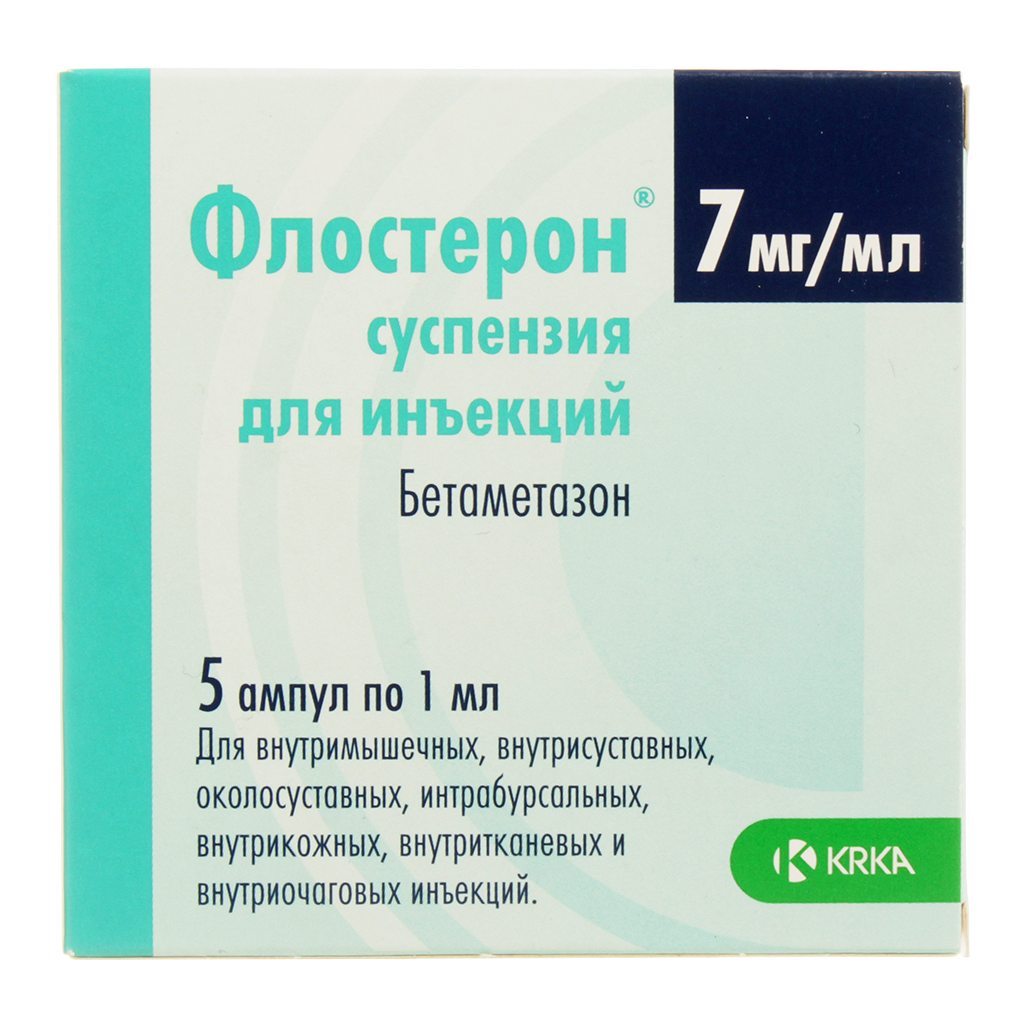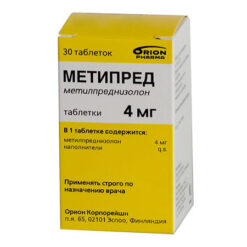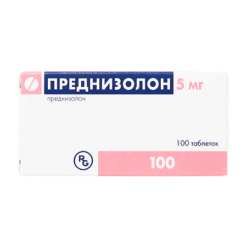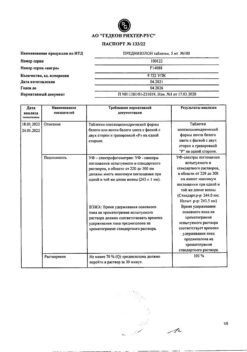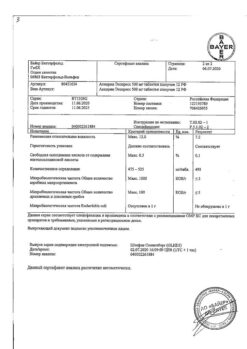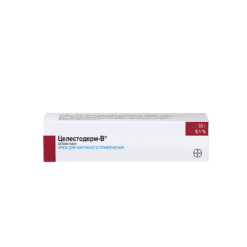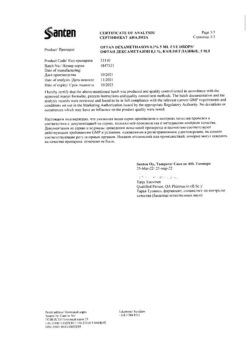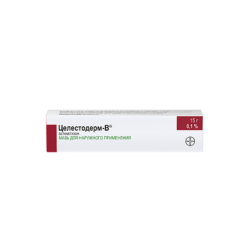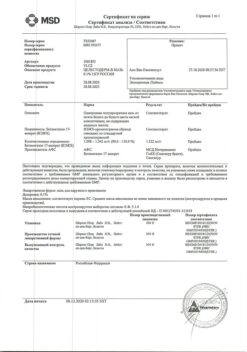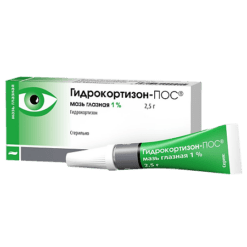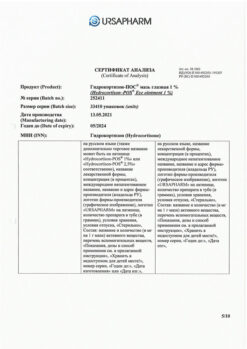No products in the cart.
Flosterone, 7 mg/ml suspension 1 ml 5 pcs
€50.21 €46.54
Description
Treatment of adult patients with conditions and diseases in which GCS therapy allows achieving the necessary clinical effect (it is necessary to take into account that in some diseases GCS therapy is additional and does not replace standard therapy):
– diseases of the musculoskeletal system and soft tissues, including rheumatoid arthritis, osteoarthritis, bursitis, ankylosing spondylitis, epicondylitis, coccygodynia, torticollis, ganglion cyst, fasciitis;
– allergic diseases, including bronchial asthma, hay fever (pollinosis), allergic bronchitis, seasonal or year-round rhinitis, drug allergy, serum sickness, reactions to insect bites;
– dermatological diseases, including atopic dermatitis, nummular eczema, neurodermatitis, contact dermatitis, severe photodermatitis, urticaria, lichen planus, alopecia areata, discoid lupus erythematosus, psoriasis, keloid scars, pemphigus vulgaris, cystic acne;
– systemic connective tissue diseases, including systemic lupus erythematosus, scleroderma, dermatomyositis, periarteritis nodosa;
– hemoblastoses (palliative therapy of leukemia and lymphomas in adult patients, acute leukemia in children);
– primary or secondary adrenal cortex insufficiency (with mandatory simultaneous use of mineralocorticosteroids);
– other diseases and pathological conditions requiring systemic GCS therapy (adrenogenital syndrome, regional ileitis, pathological changes in the blood when GCS therapy is required).
Indications
Indications
Treatment in adult patients of conditions and diseases in which GCS therapy allows to achieve the necessary clinical effect (it must be borne in mind that for some diseases GCS therapy is additional and does not replace standard therapy):
– diseases of the musculoskeletal system and soft tissues, including rheumatoid arthritis, osteoarthritis, bursitis, ankylosing spondylitis, epicondylitis, coccydynia, torticollis, ganglion cyst, fasciitis;
– allergic diseases, incl. bronchial asthma, hay fever (hay fever), allergic bronchitis, seasonal or year-round rhinitis, drug allergies, serum sickness, reactions to insect bites;
– dermatological diseases, including atopic dermatitis, coin-shaped eczema, neurodermatitis, contact dermatitis, severe photodermatitis, urticaria, lichen planus, alopecia areata, discoid lupus erythematosus, psoriasis, keloid scars, pemphigus vulgaris, cystic acne;
– systemic connective tissue diseases, including systemic lupus erythematosus, scleroderma, dermatomyositis, periarteritis nodosa;
– hemoblastoses (palliative therapy of leukemia and lymphomas in adult patients, acute leukemia in children);
– primary or secondary insufficiency of the adrenal cortex (with mandatory simultaneous use of mineralocorticosteroids);
– other diseases and pathological conditions requiring systemic GCS therapy (adrenogenital syndrome, regional ileitis, pathological changes in the blood if GCS therapy is necessary).
Pharmacological effect
Pharmacological effect
Pharmacotherapeutic group
glucocorticosteroid
ATX code
H02AB01
Pharmacodynamics:
Betamethasone is a synthetic corticosteroid that inhibits the release of interleukin-1, interleukin-2, interferon gamma from lymphocytes and macrophages. It has anti-inflammatory, antiallergic, desensitizing, antishock, antitoxic and immunosuppressive effects. Suppresses the release of adrenocorticotropic hormone (ACTH) and beta-lipotropin by the pituitary gland, but does not reduce the concentration of beta-endorphin circulating in the blood plasma. Inhibits the secretion of thyroid-stimulating hormone (TSH) and follicle-stimulating hormone (FSH).
Increases the excitability of the central nervous system (CNS), reduces the number of lymphocytes and eosinophils. Increases the number of red blood cells (due to increased production of erythropoietin).
It interacts with specific cytoplasmic receptors and forms a complex that penetrates the cell nucleus and stimulates the synthesis of matrix ribonucleic acid (RNA), the latter induces the formation of proteins, including linocortin, that mediate cellular effects. Linocortin inhibits phospholipase A2, suppresses the release of arachidonic acid and suppresses the synthesis of endoperoxides, prostaglandins (Pg), leukotrienes, which contribute to inflammation, allergies, etc.
Protein metabolism: reduces the amount of protein in the blood plasma (due to globulins) with an increase in the albumin/globulin ratio, increases the synthesis of albumins in the liver and kidneys, increases protein catabolism in muscle tissue.
Lipid metabolism: increases the synthesis of higher fatty acids and triglycerides, redistributes fat (accumulation of fat mainly in the shoulder girdle, face, abdomen), leads to the development of hypercholesterolemia.
Carbohydrate metabolism: increases the absorption of carbohydrates from the gastrointestinal tract (GIT), increases the activity of glucose-6-phosphatase, leading to an increase in the flow of glucose from the liver into the blood, increases the activity of phosphoenolpyruvate carboxylase and the synthesis of aminotransferases, leading to the activation of gluconeogenesis.
Water-electrolyte metabolism: retains Na+ ions and water in the body, stimulates the excretion of K+ ions (mineralocorticosteroid activity), reduces the absorption of Ca2+ from the gastrointestinal tract, “washes out” Ca2+ ions from the bones, increases the excretion of Ca2+ ions by the kidneys.
The anti-inflammatory effect is associated with inhibition of the release of inflammatory mediators by eosinophils; inducing the formation of linocortin and reducing the number of mast cells that produce hyaluronic acid; with a decrease in capillary permeability; stabilization of cell membranes and organelle membranes (especially lysosomal ones).
The antiallergic effect develops as a result of suppression of the synthesis and secretion of allergy mediators, inhibition of the release of histamine and other biologically active substances from sensitized mast cells and basophils, T- and B-lymphocytes, mast cells, a decrease in the sensitivity of effector cells to allergy mediators, inhibition of antibody formation, and changes in the body’s immune response.
In chronic obstructive pulmonary disease (COPD), the action is based mainly on inhibition of inflammatory processes, inhibition of development or prevention of swelling of the mucous membranes, inhibition of eosinophilic infiltration of the submucosal layer of the bronchial epithelium, deposition of circulating immune complexes in the bronchial mucosa, as well as inhibition of erosion and desquamation of the mucous membrane. Increases the sensitivity of beta-adrenergic receptors of small and medium-caliber bronchi to endogenous catecholamines and exogenous sympathomimetics, reduces the viscosity of mucus by inhibiting or reducing its production.
Antishock and antitoxic effects are associated with an increase in blood pressure (BP) (due to an increase in the concentration of catecholamines circulating in the blood plasma and restoration of the sensitivity of adrenergic receptors to them, as well as vasoconstriction), a decrease in the permeability of the vascular wall, membrane protective properties, and activation of liver enzymes involved in the metabolism of endo- and xenobiotics.
The immunosuppressive effect is due to inhibition of the release of cytokines (interleukin1, interleukin2, interferon gamma) from lymphocytes and macrophages. Suppresses the synthesis and secretion of ACTH and, secondarily, the synthesis of endogenous corticosteroids. Inhibits connective tissue reactions during the inflammatory process and reduces the possibility of scar tissue formation.
Betamethasone sodium phosphate is a readily soluble compound that is well absorbed after parenteral administration into tissues and provides a rapid effect. Betamethasone dipropionate has a slower absorption. By combining these salts it is possible to create a medicine with both short-term (but fast) and long-term effects.
Depending on the method of application (intravenous (IV), intramuscular (IM), intra-articular, periarticular, intradermal (IV)) a general or local effect is achieved.
Pharmacokinetics:
Betamethasone sodium phosphate is highly soluble in water and after intramuscular administration it quickly undergoes hydrolysis and is almost immediately absorbed from the injection site, which ensures a rapid onset of therapeutic action. Almost completely eliminated within one day after administration. Betamethasone dipropionate is slowly absorbed from the depot, metabolized gradually, which causes a long-term effect of the drug and is eliminated over more than 10 days.
Betamethasone binds well to plasma proteins (62.5%). Metabolized in the liver to form predominantly inactive metabolites. It is excreted primarily by the kidneys.
Special instructions
Special instructions
The dosage regimen and route of administration are determined individually depending on the indications, severity of the disease and patient response.
The dose should be as small as possible and the period of use as short as possible. The initial dose is adjusted until the desired therapeutic effect is achieved. If after a sufficient period of time the therapeutic effect is not observed, the drug is discontinued by gradually reducing the dose of Flosteron® and another appropriate treatment method is selected.
After achieving a therapeutic effect, the maintenance dose is selected by gradually reducing the dose of betamethasone administered at appropriate intervals. The dose reduction of Flosteron® is continued until the minimum effective dose is reached.
If a stressful situation (not related to the disease) occurs or threatens to occur, it may be necessary to increase the dose of Flosteron®.
Discontinuation of the drug after long-term therapy is carried out by gradually reducing the dose.
The patient’s condition is monitored for at least a year after completion of long-term therapy or use in high doses.
Administration of the drug into soft tissues, into the lesion and inside the joint can, with a pronounced local effect, simultaneously lead to a systemic effect.
Considering the likelihood of developing anaphylactoid reactions with parenteral administration of GCS, the necessary precautions should be taken before administering the drug, especially if the patient has anamnestic indications of allergic reactions to drugs.
The drug Flosteron® contains two active substances – betamethasone derivatives, one of which – betamethasone sodium phosphate – quickly penetrates the systemic bloodstream. When using the drug Flosteron®, the possible systemic effect of the rapidly soluble fraction of the drug should be taken into account.
During the use of the drug Flosteron®, mental disorders are possible (especially in patients with emotional instability or a tendency to psychosis).
The effect of GCS is enhanced in patients with liver cirrhosis or hypothyroidism.
When using the drug Flosteron® in patients with diabetes mellitus, adjustment of hypoglycemic therapy may be required.
Patients receiving corticosteroids should not be vaccinated against smallpox. Other immunizations should not be carried out in patients receiving GCS therapy (especially in high doses), due to the possibility of developing neurological complications and a low immune response (lack of antibody formation). The drug Flosteron® should not be prescribed 8 weeks before and within 2 weeks after vaccination with killed or inactivated viral and antibacterial vaccines. However, immunization is possible during replacement therapy (for example, with primary adrenal insufficiency).
Patients using the drug Flosteron® in doses that suppress the immune system should be warned about the need to avoid contact with patients with chickenpox and measles (especially important when using the drug for children).
When using the drug Flosteron®, it should be taken into account that GCS can mask signs of an infectious disease, as well as reduce the body’s resistance to infections. The use of the drug Flosteron® for active tuberculosis is possible only in cases of fulminant or disseminated tuberculosis in combination with adequate anti-tuberculosis therapy. When using the drug Flosteron®, patients with latent tuberculosis or with a positive reaction to tuberculin should decide on preventive anti-tuberculosis therapy. When using rifampicin prophylactically, acceleration of the hepatic clearance of betamethasone should be taken into account (dose adjustment may be required).
If there is fluid in the joint cavity, a septic process should be excluded. A noticeable increase in pain, swelling, increased temperature of the surrounding tissues and further limitation of joint mobility indicate infectious arthritis. Once the diagnosis is confirmed, antibacterial therapy must be prescribed.
Repeated injections into a joint for osteoarthritis may increase the risk of joint destruction. The introduction of GCS into the tendon tissue gradually leads to tendon rupture. After successful intra-articular therapy, the patient should avoid overloading the joint.
Long-term use of corticosteroids can lead to posterior subcapsular cataracts (especially in children), glaucoma with possible damage to the optic nerve and may contribute to the development of secondary eye infections (fungal or viral). It is necessary to periodically conduct an ophthalmological examination, especially in patients using the drug Flosteron® for more than 6 months.
With an increase in blood pressure, fluid retention and hypernatremia and an increase in the excretion of potassium ions from the body (less likely than with the use of other corticosteroids), patients are recommended to follow a diet with limited salt and are additionally prescribed potassium-containing drugs. All corticosteroids enhance the excretion of calcium ions.
When using the drug Flosteron® simultaneously with cardiac glycosides or drugs that affect the electrolyte composition of blood plasma, control of water-electrolyte metabolism is required.
Use acetylsalicylic acid with caution simultaneously with the drug Flosteron® for hypoprothrombinemia.
The development of secondary adrenal insufficiency due to too rapid withdrawal of GCS therapy is possible within several months after the end of therapy. If a stressful situation occurs or threatens to occur during this period, therapy with Flosteron® should be resumed and a mineralocorticosteroid drug should be prescribed at the same time (due to a possible disturbance in the secretion of mineralocorticosteroids). Gradual withdrawal of GCS therapy can reduce the risk of developing secondary adrenal insufficiency.
It is possible to suppress the reaction when performing skin tests during the use of GCS. GCS should be used with caution in patients with hypothyroidism or myasthenia gravis.
Particular care must be taken when considering the possibility of systemic use of GCS in patients with active herpetic eye lesions (keratitis caused by the herpes simplex virus).
Cases of Kaposi’s sarcoma have been reported in patients receiving corticosteroids; discontinuation of this therapy can lead to remission of the disease.
Symptoms of peritoneal irritation or reduction in pain due to perforation of the walls of the stomach or intestines may be minimal or absent in patients receiving GCS.
The immunosuppressive effect of GCS can lead to activation of a latent infection or exacerbation of intercurrent infections, including infections caused by microorganisms: Candida, Mycobacterium, Toxoplasma, Strongyloides, Pneumocystis, Cryptococcus, Nocardia or Ameba.
Particular caution should be exercised when using GCS in patients with confirmed or suspected Strongyloides infection. In such patients, GCS-induced immunosuppression can lead to Strongyloides hyperinfection and spread of infection through larval migration, which is often accompanied by severe enterocolitis and Gram-negative septicemia, possibly with fatal outcome.
Since corticosteroids may aggravate the course of latent amebiasis, all patients with unexplained diarrhea or patients arriving from countries with a tropical climate should be examined to exclude amebiasis before initiating corticosteroid therapy.
If a stressful situation occurs or threatens (not related to the disease), it may be necessary to increase the dose of the drug Flosteron®; the drugs of choice as a supplement should be hydrocortisone and cortisone.
During long-term therapy with GCS, it is advisable to consider the possibility of switching from parenteral GCS to GCS for oral administration, taking into account the assessment of the benefit/risk ratio.
Use in pediatrics
Children undergoing therapy with Flosteron® (especially long-term therapy) should be closely monitored for possible growth retardation and the development of adrenal insufficiency.
Fertility
With the use of GCS, changes in sperm motility and number are possible.
Impact on the ability to drive vehicles and machinery:
During the treatment period, it is necessary to refrain from driving vehicles and engaging in potentially hazardous activities that require increased concentration and speed of psychomotor reactions.
Active ingredient
Active ingredient
Betamethasone
Composition
Composition
1 ampoule – 1 ml of injection suspension contains:
Active substance:
Betamethasone as:
– betamethasone dipropionate 6.43 mg (corresponding to 5 mg betamethasone),
– betamethasone sodium phosphate 2.63 mg (corresponding to 2 mg of betamethasone).
Excipients: disodium phosphate dihydrate 2.50 mg, sodium chloride 5.00 mg, disodium edetate 0.10 mg, polysorbate 80 0.50 mg, benzyl alcohol 9.00 mg, methyl parahydroxybenzoate 1.30 mg, propyl parahydroxybenzoate 0.20 mg, croscarmellose sodium 5.00 mg, macrogol (polyethylene glycol) 20.00 mg, hydrochloric acid, concentrated q.s.. water for injection up to 1.00 ml
Pregnancy
Pregnancy
Due to the lack of controlled studies of the safety of betamethasone during pregnancy, the use of Flosteron® during pregnancy or in women with preserved reproductive potential is indicated only when the expected therapeutic effect for the mother outweighs the risk of a possible negative effect of the drug on the fetus.
Newborns whose mothers received therapeutic doses of GCS during pregnancy should be under medical supervision (for early detection of signs of adrenal insufficiency). GCS penetrate the placental barrier and can reach high concentrations in the fetus.
The use of GCS in pregnant animals can cause fetal malformations, including cleft palate (cleft palate), intrauterine growth retardation, and affect the growth and development of the brain. There is no evidence that the use of corticosteroids in humans leads to an increase in the incidence of congenital malformations such as cleft palate/lip.
However, with prolonged or repeated use during pregnancy, the use of GCS may increase the risk of intrauterine growth retardation. Theoretically, after perinatal use of GCS, it is possible to develop adrenal hypofunction in newborns, which, as a rule, resolves spontaneously after birth and in rare cases is clinically significant. Cases of myocardial hypertrophy and gastroesophageal reflux have been reported in neonates when betamethasone was used during pregnancy.
Like all drugs, GCS should be prescribed during pregnancy only if the potential benefit to the mother significantly outweighs the potential risk to the fetus. However, if it is necessary to use GCS, women with a normal pregnancy can receive GCS therapy as if they were not pregnant. The condition of patients with gestosis in the second half of pregnancy or fluid retention (especially preeclampsia) should be carefully monitored.
When used systemically in pregnant women, betamethasone can lead to a transient decrease in heart rate (HR) and inhibition of fetal biophysical activity, which are widely used to assess the condition of the fetus. These characteristics may include decreased respiratory rate, fetal motility, and fetal heart rate.
Breastfeeding period
If it is necessary to use the drug Flosteron® during breastfeeding, given the importance of GCS therapy for the mother and the possibility of developing undesirable effects in the child, breastfeeding should be stopped.
Contraindications
Contraindications
– Hypersensitivity to betamethasone or other components of the drug, or other corticosteroids;
– systemic mycoses;
– intravenous or subcutaneous administration;
– with intra-articular injection: unstable joint, infectious arthritis;
– introduction into infected cavities and intervertebral space;
– epidural, intrathecal administration and administration of the drug directly into the muscle tendons;
– coagulation disorders (including treatment with anticoagulants);
– simultaneous administration of immunosuppressive doses of the drug with live or attenuated vaccines;
– cerebral edema due to traumatic brain injury;
– breastfeeding period;
– children under 3 years of age (contains gasoline alcohol).
With caution:
– Parasitic and infectious diseases of a viral, fungal or bacterial nature (currently or recently suffered, including recent contact with a patient) – herpes simplex, herpes zoster (viremic phase), chicken pox, measles, amoebiasis, strongyloidiasis (established or suspected), active and latent tuberculosis. Use for severe infectious diseases is permissible only against the background of specific therapy;
– post-vaccination period (a period of 8 weeks before and 2 weeks after vaccination), lymphadenitis after BCG vaccination;
– immunodeficiency conditions (including acquired immune deficiency syndrome (AIDS) or human immunodeficiency virus (HIV) infection);
– diseases of the gastrointestinal tract: gastric and duodenal ulcers, esophagitis, gastritis, acute or latent peptic ulcers, recently created intestinal anastomosis, ulcerative colitis with the threat of perforation or abscess formation, diverticulitis, abscess or other purulent infections;
– diseases of the cardiovascular system, including recent myocardial infarction (in patients with acute and subacute myocardial infarction, the necrosis focus may spread, slowing down the formation of scar tissue and, as a result, rupture of the heart muscle), uncompensated chronic heart failure (CHF), arterial hypertension, hyperlipidemia;
– endocrine diseases – diabetes mellitus (including decreased glucose tolerance), thyrotoxicosis, hypothyroidism, Itsenko-Cushing’s disease;
– severe chronic renal and/or liver failure, nephrourolithiasis, liver cirrhosis;
– thrombocytopenic purpura (intramuscular administration);
– hypoalbuminemia and conditions predisposing to its occurrence;
– systemic osteoporosis, myasthenia gravis, acute psychosis, obesity (III-IV degrees), poliomyelitis (except for the form of bulbar encephalitis), open- and closed-angle glaucoma, eye diseases caused by Herpes simplex (due to the risk of corneal perforation), pregnancy;
– for intra-articular administration: the general serious condition of the patient, the ineffectiveness (or short duration) of the action of the 2 previous injections (taking into account the individual properties of the GCS used);
– use in elderly patients due to increased sensitivity to GCS, especially in postmenopausal women (high risk of osteoporosis);
– with convulsive syndrome.
Side Effects
Side Effects
The frequency of development and severity of side effects, as with the use of other corticosteroids, depend on the dose and duration of use of the drug. These effects are usually reversible and can be eliminated or reduced by reducing the dose.
Immune system disorders: anaphylactic reactions, anaphylactic shock, angioedema.
Endocrine system disorders: suppression of adrenal and pituitary function, secondary adrenal insufficiency (especially during periods of stress due to illness, injury, surgery), Itsenko-Cushing syndrome, decreased glucose tolerance, “steroid” diabetes mellitus or manifestation of latent diabetes mellitus, increased need for insulin or oral hypoglycemic drugs, delayed growth and sexual development in children, hirsutism, hypertrichosis.
Metabolic and nutritional disorders: negative nitrogen balance (due to protein catabolism), lipomatosis (including mediastinal and epidural lipomatosis, which can cause neurological complications), weight gain, increased appetite, hypernatremia, increased excretion of potassium ions, increased excretion of calcium ions, hypokalemic alkalosis, fluid retention in tissues.
Mental disorders: euphoria, mood changes, depression (with severe psychotic reactions), personality disorders, increased irritability, insomnia.
Nervous system disorders: convulsions, increased intracranial pressure with papilledema (usually after completion of therapy), dizziness, headache, neuritis, neuropathy, paresthesia, with intrathecal administration – arachnoiditis, meningitis, paresis/paralysis. sensory disturbances.
Visual disorders: posterior subcapsular cataract, increased intraocular pressure, glaucoma, exophthalmos; in rare cases, blindness (when the drug is administered to the face and head).
Cardiac disorders: CHF (in predisposed patients), cardiac arrhythmias, bradycardia, tachycardia, hypertrophic myopathy in premature infants, myocardial rupture after a recent myocardial infarction.
Vascular disorders: increased blood pressure, thromboembolic complications, vasculitis, decreased blood pressure.
Gastrointestinal disorders: erosive and ulcerative lesions of the gastrointestinal tract with possible subsequent perforation and bleeding, flatulence, hiccups, nausea.
Disorders of the liver and biliary tract: pancreatitis, hepatomegaly, increased activity of liver enzymes (usually reversible).
Disorders of the skin and subcutaneous tissues: impaired wound healing, atrophy and thinning of the skin, petechiae, ecchymoses, increased sweating, dermatitis, steroid acne, striae, a tendency to develop pyoderma and candidiasis, decreased response to skin tests, urticaria, skin rash, thinning of scalp hair, allergic dermatitis, erythema.
Musculoskeletal and connective tissue disorders: muscle weakness, “steroid” myopathy, loss of muscle mass, increased myasthenic symptoms in pseudoparalytic myasthenia gravis, osteoporosis, vertebral compression fracture, aseptic necrosis of the femoral or humeral head, pathological fractures of long bones, tendon ruptures, joint instability (with repeated intra-articular injections).
Disorders of the genital organs and breast: menstrual irregularities.
Pregnancy, postpartum and perinatal conditions: disorders of intrauterine development.
General disorders and disorders at the injection site (associated with parenteral administration of the drug): rarely – hyper- or hypopigmentation, subcutaneous and cutaneous atrophy, aseptic abscesses, flushing of the facial skin after injection (or intra-articular administration), neurogenic arthropathy.
Interaction
Interaction
With the simultaneous use of phenobarbital, rifampicin, phenytoin, aminoglutethimide or ephedrine, it is possible to accelerate the metabolism of the drug while reducing its therapeutic activity.
When using corticosteroids and estrogens simultaneously, dose adjustment of Flosteron® may be required (due to the risk of overdose).
With the simultaneous use of the drug Flosteron® and potassium-sparing diuretics, the likelihood of developing hypokalemia increases.
The simultaneous use of corticosteroids and cardiac glycosides increases the risk of arrhythmia or digitalis intoxication (due to hypokalemia).
The drug Flosteron® may enhance the excretion of potassium ions caused by amphotericin B.
With the simultaneous use of the drug Flosteron® and indirect anticoagulants, changes in blood clotting are possible, requiring adjustment of the dose of anticoagulants.
With the combined use of GCS with non-steroidal anti-inflammatory drugs (NSAIDs) or with ethanol and ethanol-containing drugs, it is possible to increase the incidence or intensity of erosive and ulcerative lesions of the gastrointestinal tract.
With simultaneous use, GCS can reduce the concentration of salicylates in the blood plasma.
Simultaneous administration of GCS and somatotropin may slow down the absorption of the latter (administration of doses of betamethasone exceeding 0.3-0.45 mg/m2 of body surface per day should be avoided).
GCS may interfere with the nitrogen blue tetrazole test for bacterial infection and cause a false negative result.
When using the drug Flosteron® in patients with diabetes mellitus, adjustment of hypoglycemic therapy may be required.
GCS may reduce the effects of cholinesterase inhibitors.
When used simultaneously with prednisolone, a decrease in the concentration of isoniazid in the blood plasma was observed. Patients taking isoniazid should be carefully monitored.
The simultaneous use of cyclosporine and corticosteroids may lead to increased effects of both drugs. There is a high risk of developing epileptic seizures.
The simultaneous use of some GCS with inhibitors of the CYP3A4 isoenzyme (for example, macrolide antibiotics, ketoconazole) may reduce the elimination of GCS.
When used simultaneously with cholestyramine, it is possible to increase the excretion of corticosteroids.
Overdose
Overdose
Symptoms
Acute overdose of betamethasone does not lead to life-threatening situations. Administration of high doses of GCS for several days does not lead to undesirable consequences (except for cases of very high doses or when used for diabetes mellitus, glaucoma, exacerbation of erosive and ulcerative lesions of the gastrointestinal tract or with the simultaneous use of cardiac glycosides, indirect anticoagulants or potassium-removing diuretics).
Treatment
Careful medical monitoring of the patient’s condition is necessary, maintaining optimal fluid intake and monitoring the content of electrolytes in the blood plasma and urine (especially the ratio of sodium and potassium ions). If necessary, appropriate therapy should be carried out.
Storage conditions
Storage conditions
In a place protected from light, at a temperature not exceeding 25 ° C.
Keep out of the reach of children.
Shelf life
Shelf life
3 years.
Do not use the drug after the expiration date.
Manufacturer
Manufacturer
KRKA dd Novo Mesto, Slovenia
Additional information
| Manufacturer | KRKA dd Novo mesto, Slovenia |
|---|---|
| Medication form | suspension for injection |
| Brand | KRKA dd Novo mesto |
Related products
Buy Flosterone, 7 mg/ml suspension 1 ml 5 pcs with delivery to USA, UK, Europe and over 120 other countries.

